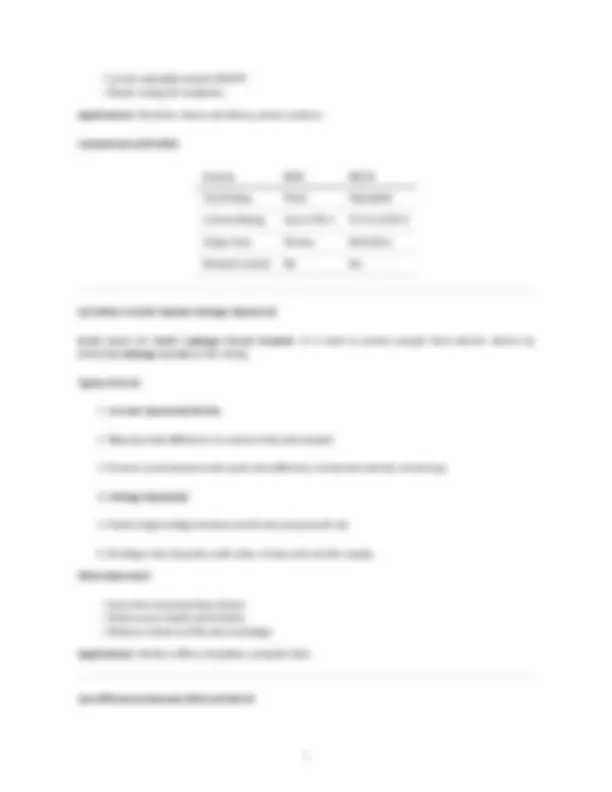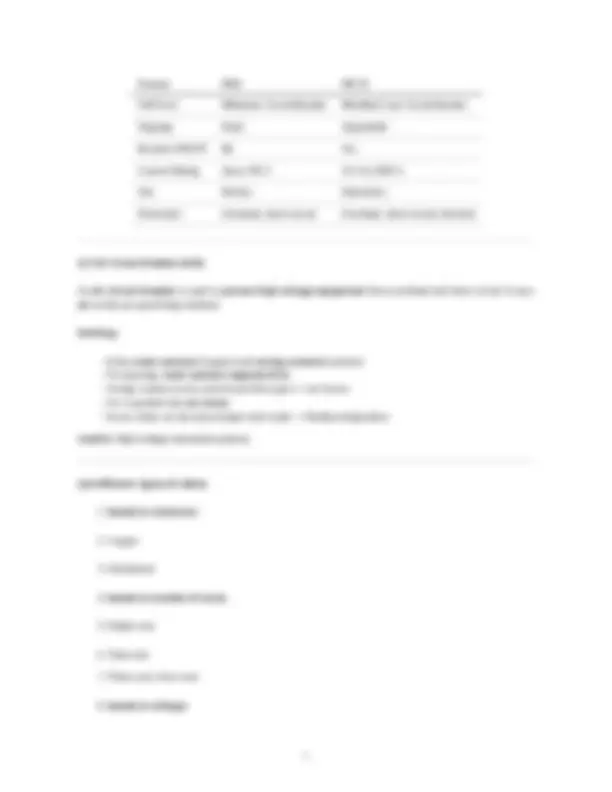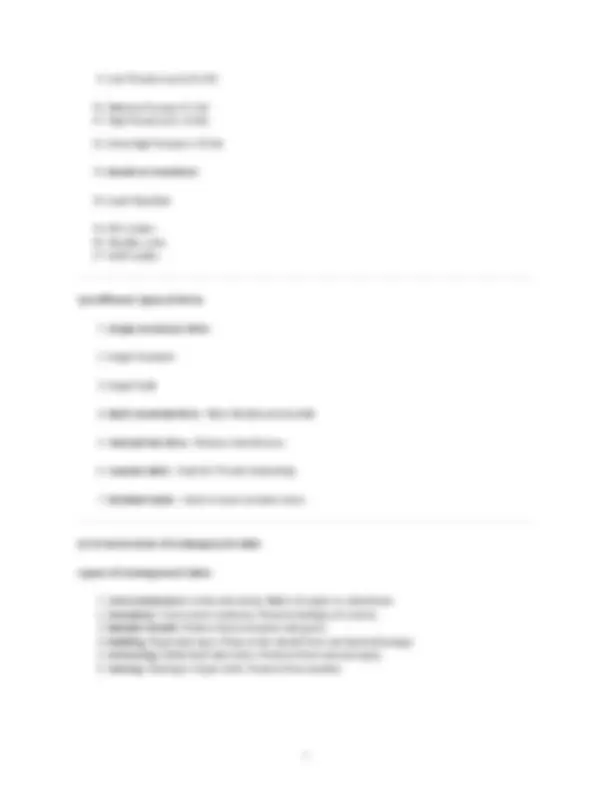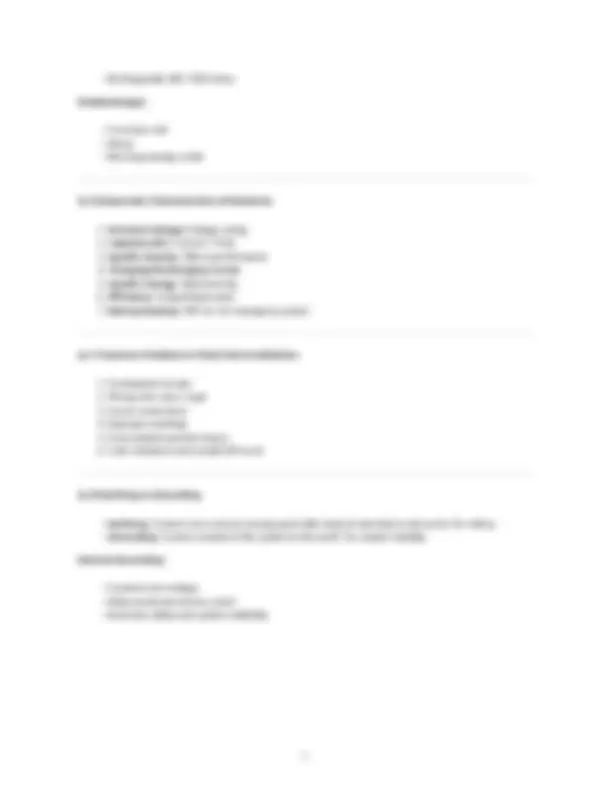






Study with the several resources on Docsity

Earn points by helping other students or get them with a premium plan


Prepare for your exams
Study with the several resources on Docsity

Earn points to download
Earn points by helping other students or get them with a premium plan
Community
Ask the community for help and clear up your study doubts
Discover the best universities in your country according to Docsity users
Free resources
Download our free guides on studying techniques, anxiety management strategies, and thesis advice from Docsity tutors
These notes are specially designed for B.Tech CSE 1st year students studying under AKTU (Dr. A.P.J. Abdul Kalam Technical University). This Unit 5 – Electrical Installation covers all important topics in easy and simple English, making it super helpful for last-minute exam preparation. ✔️ Fully based on AKTU syllabus ✔️ All important definitions, concepts, and diagrams included ✔️ Simple language for better understanding ✔️ Perfect for scoring 7-mark and 3-mark questions ✔️ Helpful for quick revision before exams Whether you're aiming to clear your exam or score high, these notes are made just for you!
Typology: Study notes
1 / 8

This page cannot be seen from the preview
Don't miss anything!





Electrical Engineering Notes (Simple English & Detailed for Exams)
Q.1 Define Switchgear with Examples
Switchgear means a group of electrical devices used to:
Switch ON or OFF the electrical supply, Control the flow of current, Protect electrical equipment from faults like short circuit or overload.
Examples of Switchgear Components:
Circuit Breakers (CB): Open the circuit when a fault occurs. Switches: Used to manually turn the power ON or OFF. Fuses: Melt when too much current flows and break the circuit. Switch Fuse Units (SFU): Combine switch and fuse for protection and control. Isolators (Off-load Switches): Disconnect part of a circuit for maintenance. HRC (High Rupturing Capacity) Fuses: High-capacity fuses used in industrial protection. Contactors: Automatically control power in motors. Earth Leakage Circuit Breaker (ELCB): Protect people from electric shocks due to leakage current.
Switchgear is essential in every electrical system for safety , control , and operation.
Q.2 Explain Switch Fuse Unit (SFU)
A Switch Fuse Unit (SFU) is a protective device that combines a switch and a fuse in one body.
The switch allows manual ON/OFF operation of the power supply. The fuse protects against short circuits and overloads by melting when excess current flows.
Working Principle:
Fuse operates on heating effect of electric current. When the current is too high, it heats and melts the fuse wire, breaking the circuit.
Types of Fuses in SFU:
Round Type Fuse Kit-Kat Type Fuse Cartridge Fuse HRC Fuse
Advantages:
Easy to install and maintain.
Saves space due to compact design. Reduces extra wiring as switch and fuse are in one unit.
Used in: Homes, small factories, and commercial buildings.
Q.3 Short Notes on MCB (Miniature Circuit Breaker)
An MCB is an automatic protective device that automatically turns OFF the circuit when there is too much current (overload or short circuit).
Working Principle:
It works on both thermal (bimetallic strip) and magnetic (electromagnetic coil) effects.
Parts of MCB:
Main Contacts: Carry the electrical load. Trip Unit: Detects overload or short-circuit current. Bimetallic Strip: Bends with heat (overload condition). Magnetic Coil: Instantly trips during a short circuit. Trip Spring: Helps to open contacts. Indicator: Shows whether MCB is ON or OFF.
Uses: Homes, schools, shops, and offices – wherever protection is needed.
Advantages:
Reusable (can be turned ON again after trip). Safer than fuses. Quick operation.
Q.4 Short Note on MCCB (Moulded Case Circuit Breaker)
MCCB is a circuit breaker that protects from overload, short circuit, and high current surges in bigger systems.
Working:
Uses bimetallic strip (for thermal overloads). Uses magnetic trip unit (for short circuits).
Key Features:
Adjustable tripping current settings. Suitable for high current loads.
Feature MCB MCCB
Full Form Miniature Circuit Breaker Moulded Case Circuit Breaker
Tripping Fixed Adjustable
Remote ON/OFF No Yes
Current Rating Up to 100 A 10 A to 2000 A
Use Homes Industries
Protection Overload, short circuit Overload, short circuit, thermal
Q.7 Air Circuit Breaker (ACB)
An Air Circuit Breaker is used to protect high voltage equipment from overload and short circuit. It uses air as the arc quenching medium.
Working:
It has main contacts (copper) and arcing contacts (carbon). On opening, main contacts separate first. Arcing contacts carry current and then open → arc forms. Arc is pushed into arc chute. In arc chute, arc becomes longer and cooler → finally extinguishes.
Used in: High voltage industrial systems.
Q.8 Different Types of Cables
Based on conductor:
Copper
Aluminium
Based on number of cores:
Single-core
Twin-core
Three-core, Four-core
Based on voltage:
Low Tension (up to 6.6 kV)
Medium Tension (11 kV) High Tension (22–33 kV)
Extra High Tension (>33 kV)
Based on insulation:
Lead Sheathed
PVC Cables Flexible cords XLPE Cables
Q.9 Different Types of Wires
Single Conductor Wire:
Single Stranded
Single Solid
Multi-stranded Wire – More flexible and durable
Twisted Pair Wire – Reduces interference
Coaxial Cable – Used for TV and networking
Shielded Cable – Used in noise-sensitive areas
Q.10 Construction of Underground Cable
Layers of Underground Cable:
Core (Conductor): Carries electricity. Made of copper or aluminium. Insulation: Covers each conductor. Prevents leakage of current. Metallic Sheath: Protects from moisture and gases. Bedding: Paper/jute layer. Protects the sheath from mechanical damage. Armouring: Galvanized steel wires. Protects from external injury. Serving: Final layer of jute cloth. Protects from weather.
Q.13 Types of Earthing
Rod Earthing: Metal rod inserted vertically into soil. Pipe Earthing: GI pipe with holes, placed deep in soil, surrounded by salt and charcoal. Plate Earthing: Metal plate (copper or GI) buried in soil with salt and charcoal layers.
All methods aim to lower earth resistance and provide a safe path for current.
Q.14 What is Lightning and Its Protection?
Lightning is a high-voltage discharge during storms.
Lightning Protection System (LPS):
Protects buildings and people Provides safe path for lightning to go into earth
Components:
Lightning Rods/Air Terminals – captures lightning Main Conductor Cables – carry current Ground Rods – discharge into earth Bonding hardware – connect all parts securely
Q.15 Types of Batteries and Explanation of Lead-Acid Battery
Types:
Primary Batteries: Non-rechargeable (e.g. Alkaline, Zinc-carbon) Secondary Batteries: Rechargeable (e.g. Lead-acid, Li-ion, Ni-Cd)
Lead-Acid Battery:
Has lead anode and lead dioxide cathode Uses dilute sulfuric acid (H₂SO₄) as electrolyte
Working:
Discharging: Chemical energy → Electrical energy Charging: Reverse process Forms PbSO₄ at both electrodes when used
Advantages:
High efficiency
Rechargeable 300–1500 times
Disadvantages:
Corrosion risk Heavy Not long-lasting in idle
Q.16 Important Characteristics of Batteries
Nominal Voltage: Voltage rating Capacity (Ah): Current × Time Specific Gravity: Affects performance Charging/Discharging Curves Specific Energy: Watt-hour/kg Efficiency: Output/Input ratio Battery Backup: UPS etc. for emergency power
Q.17 Common Problems in Electrical Installations
Overloaded Circuits Wrong wire size or type Loose connections Improper earthing Overcrowded junction boxes Code violations and unsafe DIY work
Q.18 Earthing vs Grounding
Earthing: Connect non-current carrying parts (like body of machine) to the earth. For safety. Grounding: Connect neutral of the system to the earth. For system stability.
Neutral Grounding:
Controls over-voltage Helps protection devices work Increases safety and system reliability